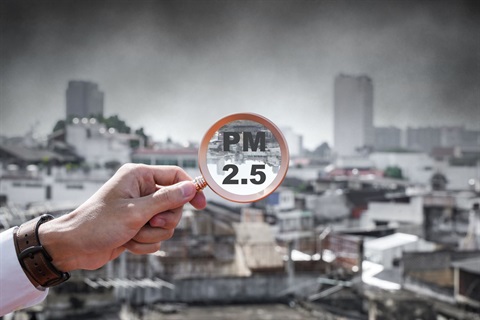What is PM2.5?

Particulate matter, also called PM, is made up of tiny pieces (particles) of solids or liquids that are in the air. For example, dust, dirt, soot, smoke, chemical compounds. Their size is less than the thickness of a human hair. We typically focus on particles with a diameter less than 10 micrometer (1 millionth of a meter or 1 twenty-five thousandth of an inch), called PM10, and even finer particles less than 2.5 micrometers , PM2.5. PM2.5 is of higher health concern because its small size allows it to travel deep into the lungs and bloodstream. In general, PM can be grouped into three types: black carbon, mineral dust, and tiny liquid droplets containing chemical compounds of carbon, sulfur, or nitrogen.
How can particulate matter negatively impact my health?
Tiny pieces of matter can enter our body through the nose and mouth when we breathe. The bigger particles (dust, pollen, mold, salt) are usually removed by the body when you breathe out, sneeze, or cough. Smaller particles (soot, animal dander) can penetrate deep into the lungs, causing serious health consequences to the lungs, heart, and even brain. These particles often carry toxic and carcinogenic materials.
The health effects would depend on how much PM2.5 is being inhaled, for how long, and if you have pre-existing health issues. Long-term exposures, such as those experienced by people living for many years in areas with high particle levels, have been associated with problems such as reduced lung function and the development of chronic bronchitis and even premature death. Short-term exposures to particles (hours or days) can aggravate lung disease, causing asthma attacks and acute bronchitis, and may also increase susceptibility to respiratory infections. In people with heart disease, short-term exposures have been linked to heart attacks and arrhythmias. Healthy children and adults have not been reported to suffer serious effects from short-term exposures, although they may experience temporary minor irritation when particle levels are elevated.
How can you avoid unhealthy exposure?
Your chances of being affected by particles increase the more strenuous your activity and the longer you are active outdoors. If your activity involves prolonged or heavy exertion, reduce your activity time or substitute another that involves less exertion. Go for a walk instead of a jog, for example. Plan outdoor activities for days when particle levels are lower. And don't exercise near busy roads because particle levels generally are higher in these areas.
Where does PM2.5 come from?
Inside your house, it can come from burning candles and incense, re-suspended particles after dusting, fireplaces, wood stoves, gas stoves, furnaces, cleaning products, cooking, smoke from tobacco and marijuana, and from outdoor sources. Outdoor sources of PM2.5 are construction/demolition, wildfires, residential or agricultural burning, factories, smokestacks, tailpipe emissions from gas or diesel-powered cars and trucks, vehicle break and tire wear, road wear, and road-dust resuspension.
Local Measurements
There is a monitor in Greeley which measure both PM2.5 and PM10 located on the roof of the Greeley hospital. You can see a map with the levels of each pollutant being measured and AQI for each on the CDPHE air quality website. Currently even with the lowered PM2.5 EPA standard, all monitors in the Denver Metro / Northern Front Range are meeting the standard according to state data.